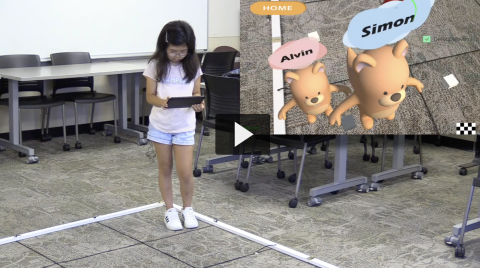Body
Image

Embodied CT in a Mixed-Reality environment
Our primary goal is to enhance children's problem-solving and computational thinking (CT) skills through engaging and interactive embodied learning experiences. To achieve this, we've created a unique mixed-reality learning environment designed specifically for young children. In this innovative setting, children engage in activities where they mimic robot movements—they move forwards and backwards, and turn right or left according to predefined symbols. This interactive environment is designed to resemble a path-finding game where kids undertake various missions in sequence. These missions challenge the children to understand and use symbols and sequences, which are fundamental concepts in CT. The mixed-reality environment makes learning immersive, allowing children to physically act out problem-solving processes by moving around a chessboard-like floor while interacting with virtual objects. As they move and complete missions, they receive real-time feedback from the system, which helps them ground abstract CT concepts in their bodily actions. These embodied learning activities in the mixed-reality environment are designed to be integrated into other learning activities, such as unplugged activities and robot programming. This integration ensures a well-rounded learning experience that is both fun and effective, making complex ideas tangible and understandable through bodily actions, immersive experiences, and gameplay.
Pillar 1: Innovative Use of Technologies in Learning and Teaching
Augmented Reality (AR) technology is utilized to create a mixed-reality learning environment where children can engage in immersive, embodied learning experiences. Motion detection technology enables the system to provide immediate feedback on the children's physical actions, facilitating a congruent embodied learning experience.
Pillar 2: Partnerships for Career and Workforce Preparation.
Six teachers from two rural schools participated in the project. Initially, the research team provided them with professional development sessions and demonstrated how to effectively teach the curriculum. Throughout the project, teachers were encouraged to actively engage in curriculum design, offering insights on learning activities and assisting with the planning of curriculum implementation. Together, the teachers and the research team successfully established a research-practice partnership.
Pillar 3: Strategies for Equity in STEM Education
Recognizing the unique perspectives of girls in rural areas, we've integrated culturally resonant elements into our curriculum, such as treasure hunts and familiar animals like squirrels and raccoons. This approach makes the content engaging and relatable. Additionally, socio-emotional learning components in our curriculum foster empathy and scientific inquiry through missions that involve helping animals.

Discipline(s)
Computer and informational technology science
Target Gradespan(s)
Early Childhood (PK)
Elementary school (K-5)
Target Participant(s)
Youth / students
Project Setting(s)
Formal Education
Category
Developing and Testing Innovations (DTI)